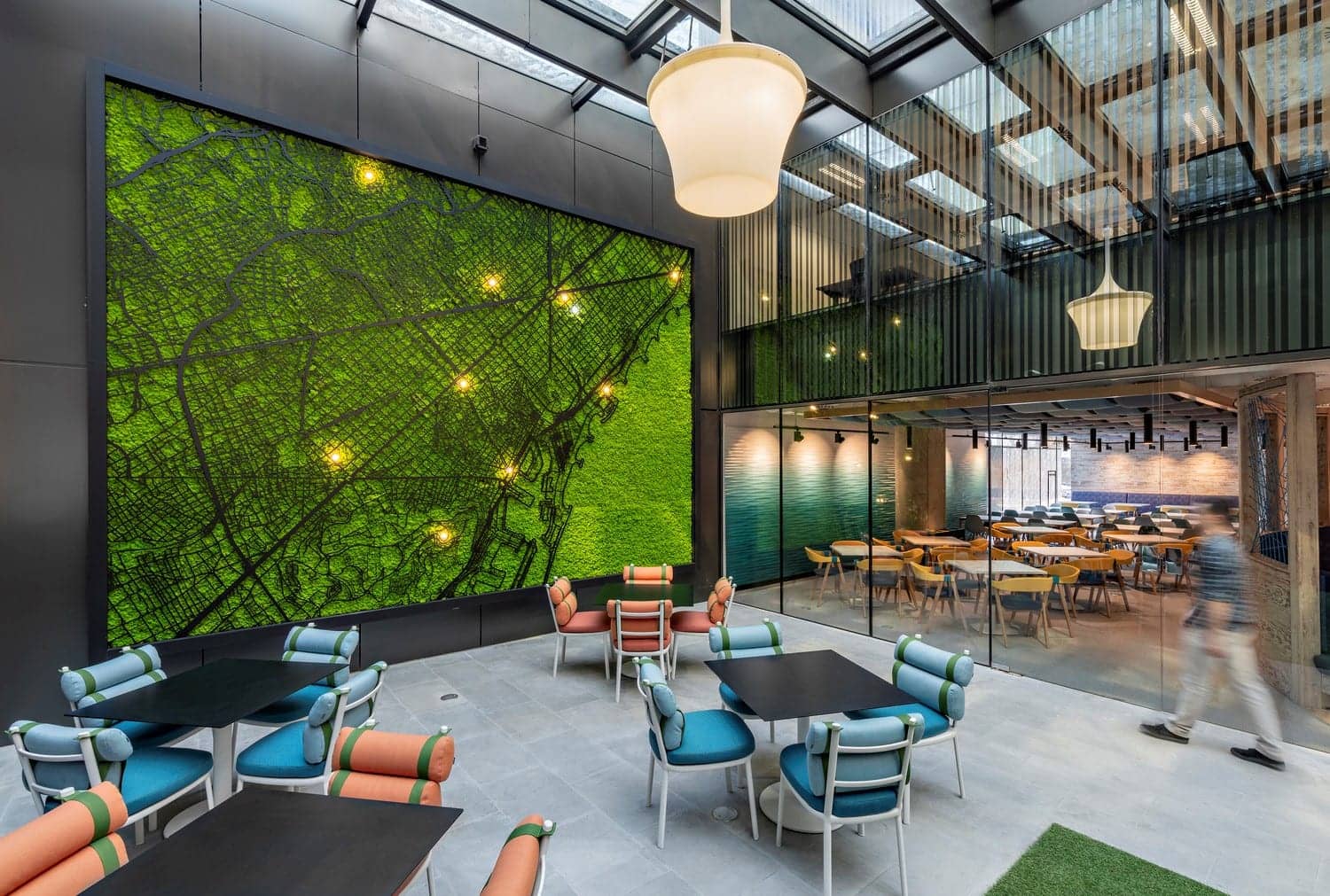More...
Mary Lee Duff, LEED AP, IIDA | Director of Ecos Studio
January 24th, 2019.
This is the first in a two-part series that considers some of the topics presented at the 2018 Academy of Neuroscience for Architecture attended by IA Director of Strategy Mary Lee Duff, Assoc. IIDA, LEED AP, and IA Senior Strategist Diane Rogers, AIA, WELL AP, which support IA’s position that the human experience will be a central design focus in 2019.

Confidential Client, Barcelona Photography © Jose F. Parreno.
Neuroscientists and Architects Discuss the Brain's Response to Stimuli and the Structured Environment.
At the 2018 Academy of Neuroscience for Architecture (ANFA), held every two years in La Jolla California, attendees participate and listen to two and a half days of speakers representing two realms: neuroscience and architecture. The conference focuses on how the neuroscience behind architecture impacts humans’ behaviors, moods, and productivity, with the understanding that as professionals architects focus on creating inspiring, aesthetic, and structured environments, and neuroscientists focus on how the brain responds to stimuli and the structure of the environment.
To start things off and as an extreme example of the brain’s response to environment, keynote speaker and renowned neuroscientist Hudo Akil, Ph.D., co-director of the Molecular & Behavioral Neuroscience Institute at the University of Michigan, discussed her study and interviews with prisoners who had experienced varied lengths of solitary confinement. Her findings showed that the impact of isolation on the brain resulted in diminished eyesight, cognitive function, memory, and sense of place. She shared that one former prisoner was unable to find his way through a hotel or down a street or to recall where he was going and had lost a significant amount of recall.
Not surprisingly, each of the speakers touched on some aspect of the fourteen principles of biophilia within the context of neuroscience and their ramifications for architecture, design, and the human experience, which goes far beyond today’s trend of greening the workplace, the allure of greenwalls, and the irony of the popularity of preserved moss.
The Science of a Visual Connection to Nature
In his presentation, Does View to Nature and Design of Spaces Matter? A Pain Stress Experiment, architect Lars Brorson Fich, who is conducting a four year research project on how the design of space influences the effects of stress, discussed his research’s support of the first principle of biophilia, the visual connection to nature. Bottom line, we are wired to respond to elements of nature, living systems, and natural processes. Our response to the presence of nature results in a measurable reduction of stress, blood pressure and heart rate. Our cognition improves too because we are spurred to be more engaged and attentive by nature’s influence, which also positively affects our emotions, moods, attitudes, and overall happiness.

IA Interior Architects, New York. Photography © Eric Laignel.
In effect, nature supports us and has from our beginning. Seeing, hearing, and sensing water in our environment assures us that we have access to the resources we need to survive and thrive.

Confidential Client, Raleigh, North Carolina. Photography © Monica Slaney.
Visual access to water sources; views of vegetation, soil, and terrain; as well as constructed views (greenwalls, aquariums, designed landscapes, etc.); and even art that depicts nature are beneficial. Gardening (especially edible plants) and animals, including domesticated animals and pets provide great satisfaction and positive cognition.
Non-Visual Connections to Nature
The same benefits to stress levels, cognition, and emotions can occur through non-visual connections to nature. Just as we benefit from seeing nature, similar positive results occur from connecting to nature through smell, taste, hearing, and touch. Architects and designers understand that haptics (the use of technology that stimulates the senses of touch and motion) are an option for creating an optimum human experience in the work environment. One speaker, David Kirsh, Ph.D., focused his talk on this area, emphasizing that we respond positively to experiences of touch that remind us of aspects of nature.
A non-visual connection to nature can be experienced through naturally occurring fragrance; the sound of songbirds, flowing water, and weather; natural ventilation; textured materials that mimic nature; and crackling fires, patches of sunlight, and warm or cool surfaces. The options are legion and they can be man-made. Digitized sounds from nature, mechanically released plant oils, and music with fractal (exhibiting similar patterns at an increasingly small scales, also referred to as expanding symmetry or unfolding symmetry) qualities are all possibilities. For strategists, designers, and architects, this can translate into the environment in a number of ways that include but go beyond the introduction of specific features and address the careful planning of air circulation and floorplans that are sensitive to the warmth of the sun, cool shade, indirect daylight, and circadian rhythm.
In her talk, Well built for Well Being: Using sensors and surveys to explore the indoor environment and health, design researcher Casey Lindberg highlighted the value of designing for subtle changes in air temperature, relative humidity, airflow across the skin, and surface temperatures that mimic natural environments. Her study supports the findings of others that thermal conditions impact comfort, productivity, and concentration.
Non-Rhythmic Sensory Stimuli
Non-Rhythmic Sensory Stimuli is another of the 14 principles of bioplilia that has a fascinating impact on people and their response, which explains a phenomenon that most of us are aware of—our innate fascination with things that don’t move in a structured or predictable way. Think about how we get lost and delighted in watching random flickering flames, cascading water, and leaves drifting in the breeze. This is referred to as a stochastic (having a random probability distribution or pattern that may be analyzed statistically but may not be predicted precisely) and ephemeral connection to nature and positively impacts heart rate, systolic blood pressure, and sympathetic nervous system activity. Plus, it increases attention span, which can be documented and quantified through behavioral measurement.
For designers the use of babbling water features, random cloud or shadow simulations, and fabrics, mobiles, or screen materials that move with breezes or produce natural sounds at unpredictable intervals are positive design elements.
The Science of Prospect
Three very intriguing principles of biophilia are the concepts of prospect, refuge, and mystery. Prospect refers to an unimpeded view over a distance for surveillance and planning. When on a nature hike we decide to stop at a ridgeline to catch our breath and discover an opportunely placed bench or a well-worn rock, we know that many others have stopped here in a similar fashion for the same reason, the view. As a species, our instincts guide us to similar situations because we have evolved successfully by those instincts. Listening to the whisper of our ancestors, we find that we have common desires for safety and comfort. Design is at its best when it rewards us with an environment that meets those needs and provides, in this case, focal lengths for prospective within the work environment—places with viewpoints such as balconies, staircases, or mezzanines, or sightlines from various work settings. The results of good planning that incorporates this principle can be statistically monitored through the reduction of stress, boredom, irritation, and the increase of a sense of perceived safety.
The Science of Refuge
Refuge may seem more intuitive in terms of its benefits. We often seek a place to withdraw that is protected from behind and overhead and away from the main flow of activity. We seek this for concentration, reflection, and peace, and science tells us that it improves cognition. Similar to the science of prospect, we crave space that protects us as well as keeps us in tune with the larger environment. In a world of over-stimulation, it is more important than ever to create spaces where people can step aside for a brief time and take a breath or two without feeling completely isolated, which we know brings its own kind of vulnerability.
Left and right, entrance to speakeasy at Confidential Client, San Francisco. Photography © Jasper Sanidad.
The Promise of Mystery
Our final principle for this discussion is mystery. This is the promise of more information to be achieved through partially obscured views or other sensory devices that entice us to travel deeper into the environment. The science behind mystery is based on our emotional response to the pleasure of discovery. Curious by nature, people feel dull and uninspired by environments that are too predictable. Having a sense that there is more to a space than initially meets the eye can enliven us and make us feel more engaged with our surroundings. At IA, we know this is true. In several recent projects we have incorporated a hidden speakeasy as a mystery spot that waits to be discovered and accessed—and the positive response has been unanimous.
Want to know more? Look for part two of this series, which will soon to be posted.




